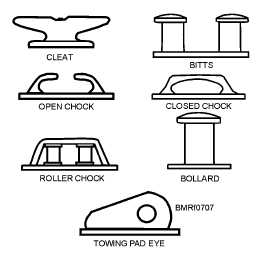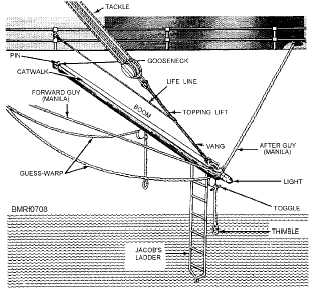DECK FITTINGS
Deck fittings are used aboard ships and boats
mainly for the securing of mooring lines. All fittings
shown in figure 7-7 are found aboard ship except the
bollard, which is a pier fitting. The pad eye shown in the
figure is not used for mooring but for towing other
vessels. Different variations of the pad eye are used for
securing heavy objects and equipment.
DAVITS
Boats carried aboard ships usually are handled by
powerful cranes and booms. These cranes and booms
hook onto slings attached to hoisting points built into
the strong parts of the boat’s structure. Boats stowed at
davits are lowered and hoisted by the davit machinery.
Basically, a set of davits is nothing more than a special
crane that is designed specifically for handling boats in a
safe and timely manner.
BOAT BOOMS
Ships that are at anchor or moored to a buoy rig out
their boat booms for the purpose of mooring their boats
well clear of the side. This method of securing is known
as hauling out to the boom. Forward booms are called
lower booms; after booms are called quarter booms.
The boat boom shown in figure 7-8 is a spar that is
secured to a gooseneck by a pin on the side of the ship.
This arrangement allows free motion fore and aft. The
outboard end of the boom hangs from a wire vang and
tackle combination called the topping lift. Fore-and-aft
motion is controlled by lines called forward and after
guys.
A strong line called a guess-warp runs from well
forward on the ship out through a block or blocks on the
boom and ends in a metal thimble through which boats
can reeve (pass) their bowlines. A small piece of wood
called a toggle is seized between strands of the
guess-warp above the thimble to keep it from running up
out of reach when a boat lets go. One or more Jacob’s
ladders (a rope ladder) from the boom permit boat
crews to come aboard.
REVIEW 1 QUESTIONS
Q1. List six types of ground tackle used aboard ships.
a.
b.
c.
d.
7-6
Student Notes:
Figure 7-7.—Deck fittings.
Figure 7-8.—Parts of a boat boom.




